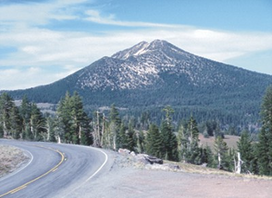| Mount Scott | |
|---|---|
 Mount Scott viewed from the southwest Mount Scott viewed from the southwest | |
| Highest point | |
| Elevation | 8,934 ft (2,723 m) |
| Prominence | 3,009 ft (917 m) |
| Listing | |
| Coordinates | 42°55′22″N 122°00′59″W / 42.92287085°N 122.016268694°W / 42.92287085; -122.016268694 |
| Geography | |
 | |
| Region(s) | Oregon, United States |
| Parent range | Cascades |
| Topo map | USGS Crater Lake East |
| Geology | |
| Rock age | About 420,000 years |
| Mountain type | Stratovolcano |
| Volcanic arc | Cascade Volcanic Arc |
| Last eruption | 420,000 years ago |
Mount Scott is a small stratovolcano and a so-called parasitic cone on the southeast flank of Crater Lake in southern Oregon. It is approximately 420,000 years old. Its summit is the highest point within Crater Lake National Park, and the tenth highest peak in the Oregon Cascades. A small fire lookout tower stands on the summit, at the end of a trail that zigzags approximately 1,500 feet (460 m) up the mountain. The mountain is named for Oregon pioneer Levi Scott, founder of Scottsburg, Oregon.
Geology
Mount Scott first erupted about 420,000 years ago and is one of the oldest volcanoes in the Mount Mazama complex. It erupted mainly andesitic lavas before becoming extinct in the late Pleistocene. Since it was relatively far away from the main flanks of Mount Mazama, it survived the mountain's massive explosion that occurred around 5700 BC. At 8,934 feet (2,723 m) tall, Mount Scott is the highest point in Crater Lake National Park. Most of the lower slopes are covered with ash, pumice, and loose gravel, while the summit is mostly covered with scoria.
Flora
Many species of plants inhabit the slopes of Mount Scott. The most common species of trees include Douglas fir, white pine, hemlock, whitebark pine, lodgepole pine. Wildflowers, such as Indian paintbrush, penstemon, forget-me-nots, wild onions, and buttercups can be found on the mountain.
Trail
There is one trail to the summit of Mount Scott. Starting on Rim Drive, the trail is about 2.5 miles (4.0 km) long. It has many switchbacks, and ends at the fire lookout tower on the summit. The trailhead is at an elevation of 7,683 feet (2,342 m), and the trail climbs approximately 1,479 feet (451 m) to the top of Mount Scott at 8,934 feet (2,723 m).
Panoramic views of Crater Lake can be seen from the summit. Mount Thielsen, Diamond Peak, Mount McLoughlin, Mount Shasta, Upper Klamath Lake, and Diamond Lake are other landmarks that can be seen from the summit.
 A panorama of Crater Lake and its surroundings from Mount Scott
A panorama of Crater Lake and its surroundings from Mount Scott
References
- ^ "8938". NGS Data Sheet. National Geodetic Survey, National Oceanic and Atmospheric Administration, United States Department of Commerce. Retrieved November 17, 2008.
- "Mount Scott, Oregon". Peakbagger.com. Retrieved April 2, 2008.
- ^ Wood, Charles A.; Kienle, Jürgen, eds. (1990). Volcanoes of North America. Cambridge University Press. pp. 193–195. ISBN 978-0-521-43811-7.
- "Crater Lake". Global Volcanism Program. Smithsonian Institution. Retrieved October 27, 2019.
- "Lexicon of Geologic Names Of the United States For 1936-1960". 1949. Retrieved October 27, 2019.
- ^ Wuerthner, George (2003). Oregon's Wilderness Areas. Big Earth Publishing. p. 94. ISBN 978-1-56579-434-4.
- Corning, Howard M. (1956). Dictionary of Oregon History. Binfords & Mort Publishing. ISBN 978-0-8323-0449-1.
- Bishop, Ellen (2003). In Search of Ancient Oregon. Timber Press. p. 233. ISBN 978-0-88192-590-6.
- Hill, Richard (2004). Volcanoes of the Cascades. Globe Pequot. p. 65. ISBN 978-0-7627-3072-8.
- ^ Harris, Ann; Tuttle, Esther; Tuttle, Sherwood (2003). Geology of National Parks (6th ed.). Kendall Hunt. pp. 530–531. ISBN 978-0-7872-9970-5. Retrieved May 12, 2009.
- ^ Bishop, Ellen; Allen, John (2004). Hiking Oregon's geology (2 ed.). The Mountaineers Books. pp. 153–154. ISBN 978-0-89886-847-0.
- "Crater Lake National Park". GORP. Archived from the original on January 13, 2010. Retrieved May 12, 2009.
- "Crater Lake, Oregon". United States Geological Survey. Retrieved May 12, 2008.
- ^ Bond, Barbara (2005). 75 Scrambles in Oregon. The Mountaineers Books. pp. 91–93. ISBN 978-0-89886-550-9.
- ^ Bernstein, Art (2001). Hiking Oregon's Southern Cascades and Siskiyous. Globe Pequot. pp. 124–125. ISBN 978-1-56044-898-3.
- Bernstein, Art (2003). Oregon Byways. Wilderness Press. p. 115. ISBN 978-0-89997-277-0.
External links
- "Mount Scott". Geographic Names Information System. United States Geological Survey, United States Department of the Interior. Retrieved November 17, 2008.
- "Mount Scott". SummitPost.org.
| Crater Lake | |
|---|---|
| Natural places | |
| Structures | |
| People | |
| Designated areas |
|
